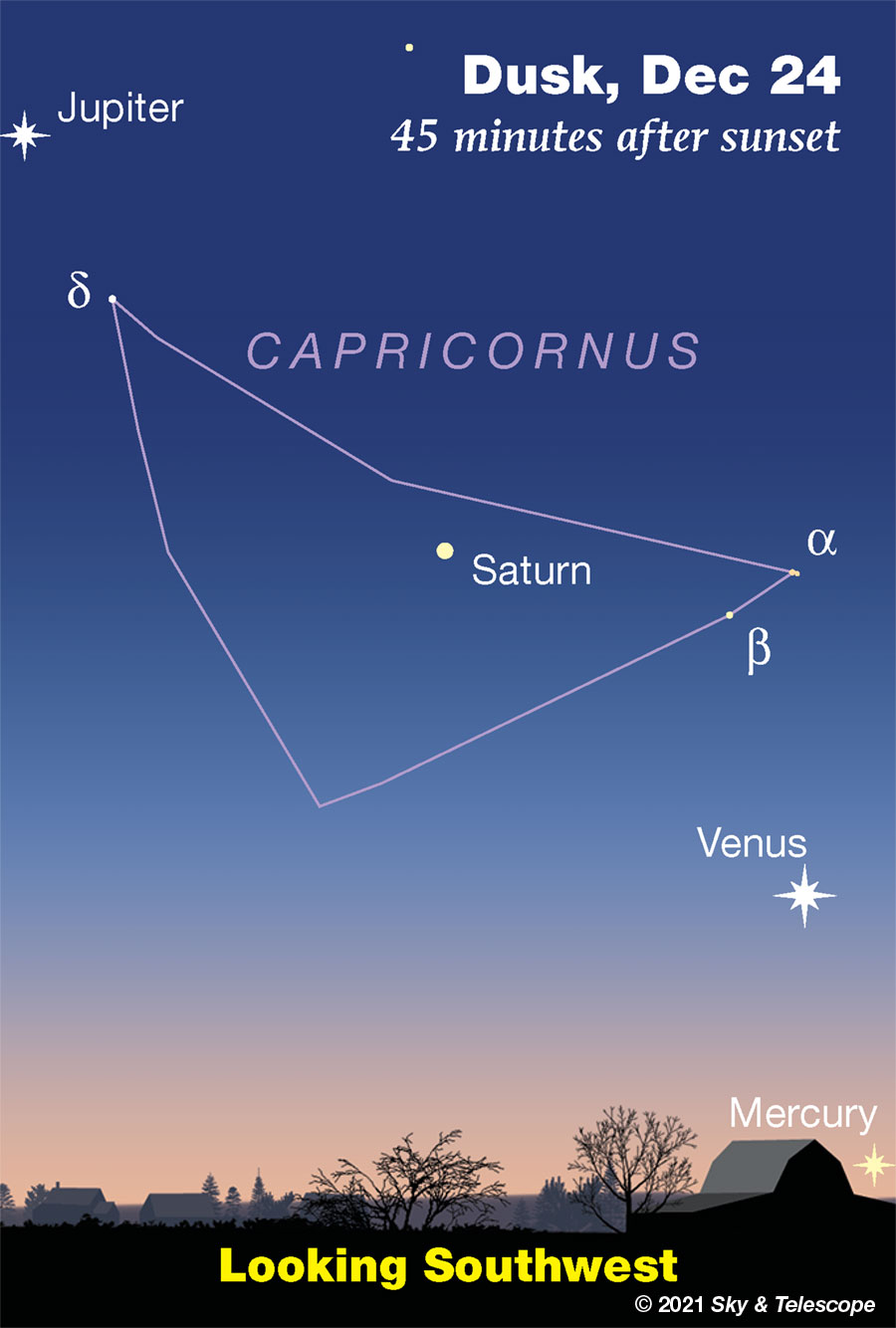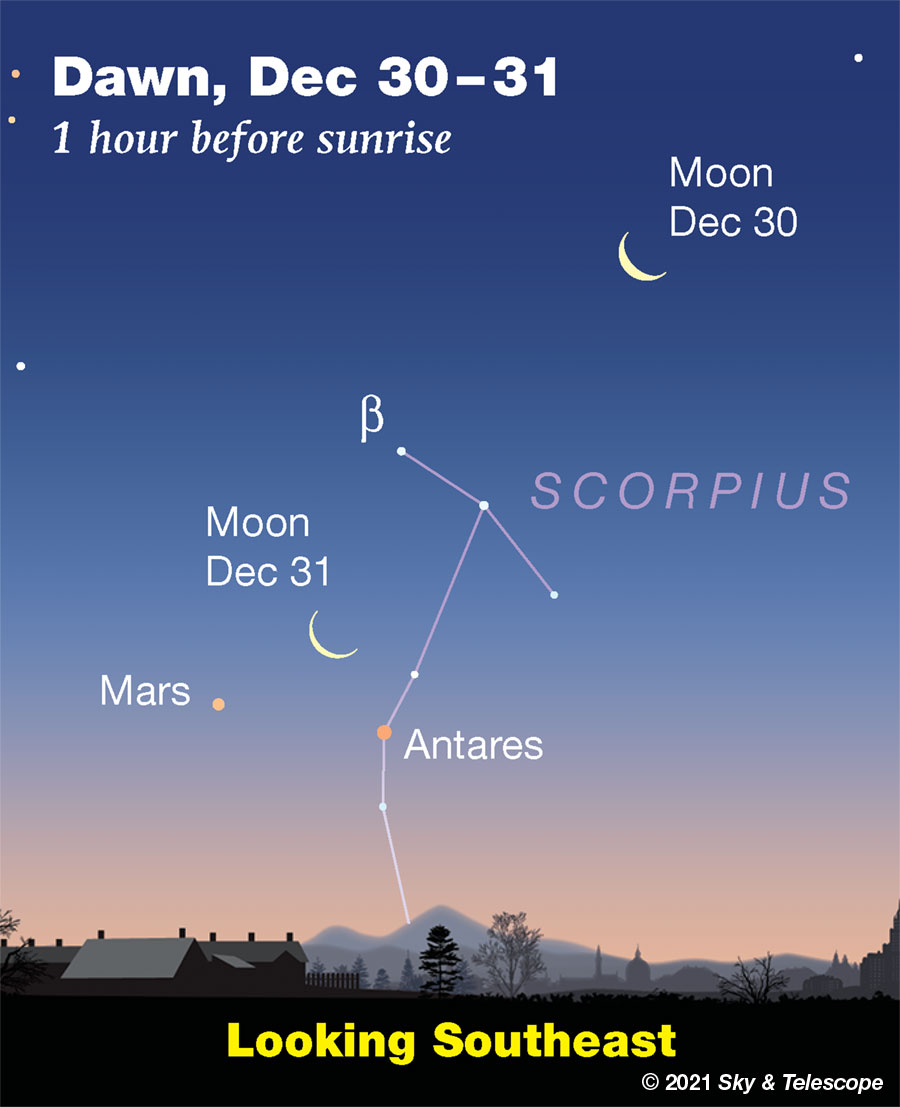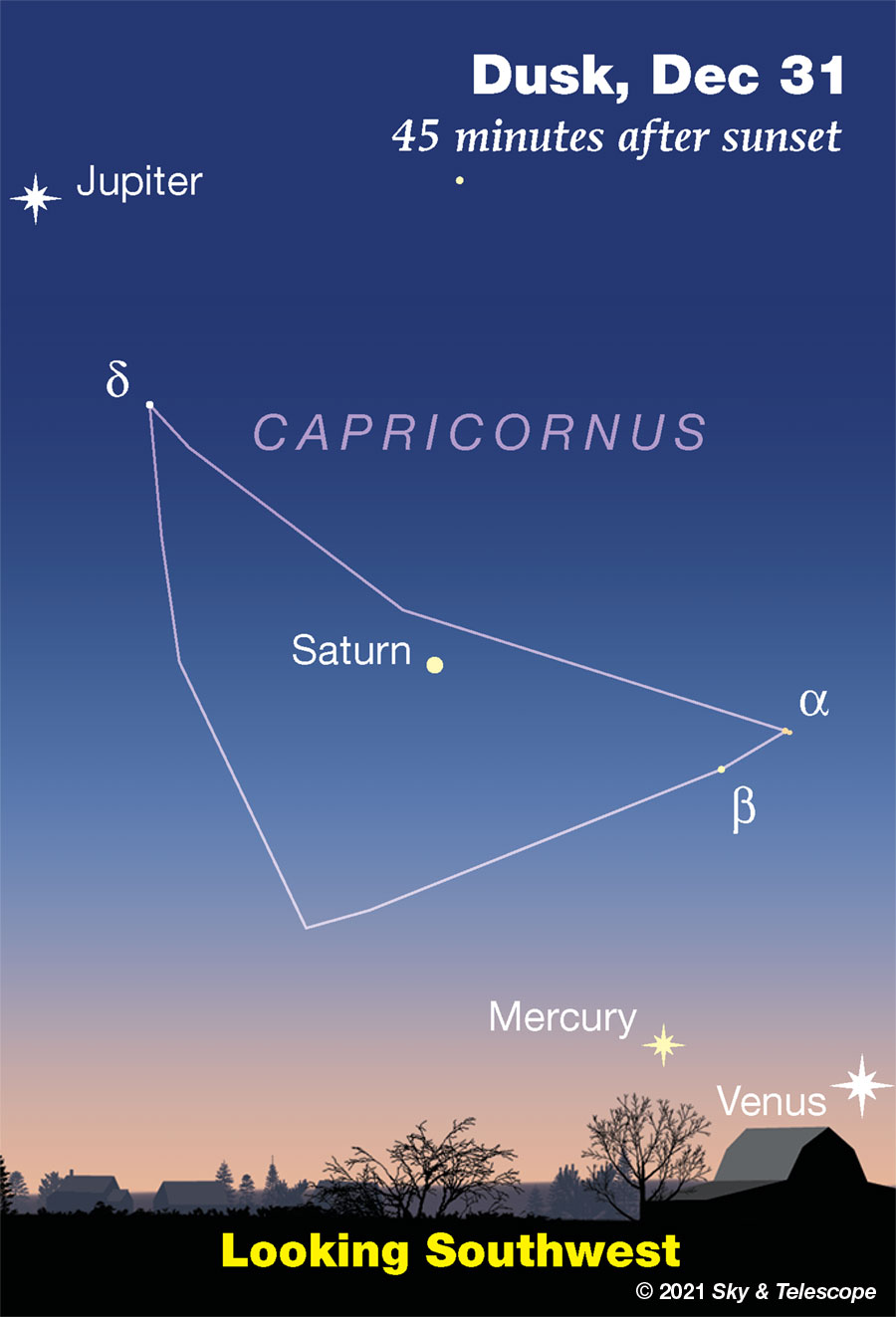FRIDAY, DECEMBER 24
■ The line of Jupiter, Saturn, and Venus in the southwest at dusk continues to evolve. Venus, the lower right end of the line, is dropping away rapidly. And the whole line is sliding farther to the lower right. Meanwhile, Mercury down below is on its way up to pass Venus.

SATURDAY, DECEMBER 25
■ High above Orion these holiday nights shines orange Aldebaran with the large, loose Hyades cluster in its background. Binoculars are the ideal instrument for this cluster given its size: its most prominent stars (4th and 5th magnitude) span an area about 4° wide. Higher above, the brightest stars of the Pleiades span hardly more than 1°.
The main Hyades stars famously form a V. It's currently lying on its side, open to the left. Aldebaran forms the lower of the V's two tips.
With binoculars, follow the lower branch of the V to the right or upper right from Aldebaran. The first thing you come to is the House asterism: a pattern of stars like a child's drawing of a house with a peaked roof. The house is currently upright and bent to the right like it got pushed.
The House includes three binocular double stars that form an equilateral triangle, with each pair facing the center. The brightest pair is Theta1 and Theta2 Tauri. You may find that you can resolve the Theta pair with your unaided eyes.
For more, see "The Noble Hyades" by Fred Schaaf in the January Sky & Telescope, page 45.
SUNDAY, DECEMBER 26
■ This is the time of year when Orion shines in the east-southeast after dinnertime. He's well up now, but his three-star Belt is still nearly vertical. The Belt points up toward Aldebaran and the Pleiades even higher. In the other direction, it points down to where bright Sirius will rise around 7 or 8 p.m. to twinkle furiously.
■ Last-quarter Moon (exactly so at 9:24 p.m. EST). The Moon rises around midnight tonight, in Virgo. By early dawn Monday morning it shines high in the south, with Spica to its lower left and Arcturus much farther to its upper left.
MONDAY, DECEMBER 27
■ The constellation figure of Orion has only a tiny, pea-brained head: 4th-magnitude Lambda Orionis and its two fainter little companions, Phi1 and Phi2. Binoculars show them well. Did you know they're part of a sparse, loose open cluster named Collinder 69? Good binoculars under a dark sky may show a dozen of its members thinly scattered over an area 1° or more across. Astronomers have identified about 100 in all. See Matt Wedel's "Head of the Hunter," his Binocular Highlight column in the January Sky & Telescope, page 43.
TUESDAY, DECEMBER 28
■ The Pleiades shine very high in the southeast far above Orion. They're about the size of your fingertip at arm's length. How many can you count with your unaided eyes? Take your time and keep looking. Most people can count 6. With sharp eyesight, a good dark sky, and a steady gaze, you may be able to make out 8 or 9.
WEDNESDAY, DECEMBER 29
■ Sirius and Procyon in the balance. Sirius, the Dog Star, rises low in the east-southeast by about 7 or 8 p.m., depending on your location. Procyon, the Little Dog Star, shines in the east about two fist-widths at arm's length to Sirius's left.
But directly left? That depends. If you live around latitude 30° (Tijuana, New Orleans, Jacksonville), the two canine stars will be at the same height above your horizon soon after they rise. If you're north of that latitude, Procyon will be higher. If you're south of there, Sirius will be the higher one. Your eastern horizon tilts differently with respect to the stars depending on your latitude.

THURSDAY, DECEMBER 30
■ Algol should be at its minimum brightness this evening, magnitude 3.4 instead of its usual 2.1, for a couple hours centered on 10:11 p.m. EST; 7:11 p.m. PST.
■ As dawn brightens on Friday morning, look low in the southeast for the waning crescent Moon lighting the way to Mars and slightly-brighter Antares, as shown above. Compare their colors. Can you detect a difference? The name "Antares" is from the Greek for rival of Mars.
Does Mars twinkle less than Antares? A planet isn't normally supposed to twinkle — because it presents an extended surface area, each point of which twinkles somewhat independently of the others so the total averages out steady. But Mars is only 4 arcseconds wide now, tinier and more similar to a pointlike star than any of the other bright planets ever get.
FRIDAY, DECEMBER 31

■ After the noise and cheering at the turning of midnight tonight, step outside into the silent, cold dark. Shining high in the south will be Sirius, with the other stars of Canis Major to its right and below it. Sirius is the bottom star of the bright, equilateral Winter Triangle. The others are Betelgeuse in Orion's shoulder to Sirius's upper right, and Procyon the same distance to Sirius's upper left. The Triangle stands upright, just about in balance. Happy New Year.
No Moon or planets grace the midnight sky.
SATURDAY, JANUARY 1
■ As we enter January, the bowl of the Little Dipper hangs straight down from Polaris around 8 or 9 p.m., as if from a nail on the cold north wall of the winter sky.
The brightest star of the Little Dipper's dim bowl is Kochab at the bowl's lip. It's the equal of Polaris. Kochab passes precisely below Polaris around 8 p.m., depending on how far east or west you live in your time zone.
This Week's Planet Roundup
Mercury is coming up from the sunset to pass Venus. On the 24th look for Mercury 9° below Venus; by the 28th it's passing 4° to Venus's lower left; and on the 31st you'll find it 7° to Venus's left or upper left. All week, Mercury remains a bold magnitude –0.7.
Venus, magnitude –4.5, rapidly sinks toward the west-southwest horizon day by day, on its way to conjunction with the Sun January 8th. Venus sets around the end of twilight on Christmas and during late twilight by New Year's.
In a telescope Venus is a dramatically thin crescent, thinning more each day. Get your scope on it as early as you can, even in the blue daytime before sunset. This week we see its crescent enlarge from 55 to 60 arcseconds tall while thinning from 8% to only 2% lit!
Mars, far and faint at magnitude +1.6, is passing Mars-colored Antares very low in the southeast in early dawn. Look for them far below high Arcturus. Antares is the brighter of these two orange dots, at magnitude +1.1. On Christmas morning Mars is 5° above or upper left of Antares. By New Year's, Mars is 6° to the star's left.
Mars is on the far side of its orbit from us, so in a telescope it's just a tiny fuzzblob 4 arcseconds wide.
Jupiter, magnitude –2.1 in Aquarius, shines in the south-southwest at dusk about three fists at arm's length upper left of Venus. It's only 36 arcseconds wide now, so don't be too disappointed by the view in a telescope.
Saturn, in Capricornus, is nearly midway between Jupiter and Venus. At magnitude +0.7, Saturn is 1/13 as bright as Jupiter.
Saturn sets about an hour after dark. Jupiter follows it down about 1½ hours later.
Uranus (magnitude 5.7, in Aries north of the head of Cetus) is very high in the southeast in early evening. See Bob King's story and finder chart.
Neptune (magnitude 7.9, in Aquarius) is less high in the south-southwest after dark.
All descriptions that relate to your horizon — including the words up, down, right, and left — are written for the world's mid-northern latitudes. Descriptions and graphics that also depend on longitude (mainly Moon positions) are for North America.
Eastern Standard Time, EST, is Universal Time (also called UT, UTC, GMT, or Z time) minus 5 hours.
Want to become a better astronomer? Learn your way around the constellations. They're the key to locating everything fainter and deeper to hunt with binoculars or a telescope.
This is an outdoor nature hobby. For an easy-to-use constellation guide covering the whole evening sky, use the big monthly map in the center of each issue of Sky & Telescope, published by the American Astronomical Society.
Once you get a telescope, to put it to good use you'll need a detailed, large-scale sky atlas (set of charts). The basic standard is the Pocket Sky Atlas (in either the original or Jumbo Edition), which shows stars to magnitude 7.6.

Next up is the larger and deeper Sky Atlas 2000.0, plotting stars to magnitude 8.5; nearly three times as many. The next up, once you know your way around, are the even larger Interstellarum atlas (stars to magnitude 9.5) or Uranometria 2000.0 (stars to magnitude 9.75). And be sure to read How to Use a Star Chart with a Telescope.
You'll also want a good deep-sky guidebook, such as the big Night Sky Observer's Guide set (2+ volumes) by Kepple and Sanner.
Can a computerized telescope replace charts? Not for beginners, I don't think, and not on mounts and tripods that are less than top-quality mechanically, meaning heavy and expensive. And as Terence Dickinson and Alan Dyer say in their Backyard Astronomer's Guide, "A full appreciation of the universe cannot come without developing the skills to find things in the sky and understanding how the sky works. This knowledge comes only by spending time under the stars with star maps in hand."
![]() Audio sky tour. Out under the evening sky with your
Audio sky tour. Out under the evening sky with your
earbuds in place, listen to Kelly Beatty's monthly
podcast tour of the heavens above. It's free.
"The dangers of not thinking clearly are much greater now than ever before. It's not that there's something new in our way of thinking, it's that credulous and confused thinking can be much more lethal in ways it was never before."
— Carl Sagan, 1996
"Facts are stubborn things."
— John Adams, 1770
 12
12









Comments
Rod
December 24, 2021 at 8:57 am
Okay, early morning news interviewed NORAD. NORAD has been tracking Santa moving down from the North Pole since earlier, Santa completed Russia and New Zealand, on the way too much more of the globe 🙂 I tried to confirm these Santa sightings using my 10-inch Newtonian and 90-mm refractor telescope by viewing Polaris and area around Ursa Major and Ursa Minor near 0000 UT and shortly after for 24-Dec. Even 10x50 binoculars could help. However, the clouds did not cooperate at my location. The waning gibbous Moon was diffused by much cirrus. I cannot confirm these Santa sightings that should be visible to telescope users like myself 🙂 Merry Christmas mary beth et al 🙂
You must be logged in to post a comment.
mary beth
December 24, 2021 at 4:15 pm
Merry, merry Christmas Rod and all!!
I have the NORAD app and tracking as well! So fun!! Well we probably going to break the record high temperature here so we are having a Hawaiian style Christmas! Mele Kalikimaka!!
“When they saw the star, they rejoiced exceedingly with great joy;” Matthew 2:10
You must be logged in to post a comment.
John-Lefebure
December 24, 2021 at 6:04 pm
I'll be dogged if I can see a House asterism in Taurus as described in your Saturday, December 25 entry. An internet search turned up nothing. I can't see it in online charts of Taurus. Thanks for any help;
You must be logged in to post a comment.
John-Lefebure
December 24, 2021 at 6:10 pm
I did find a fish hook in Taurus in my internet search.
You must be logged in to post a comment.
Anthony Barreiro
December 25, 2021 at 5:03 pm
This page has diagrams.
https://bestdoubles.wordpress.com/2011/02/06/in-the-house-of-hyades-sigma-%CF%83-theta-%CE%B8-and-delta-%CE%B4-tauri/
The asterism shows up well in binoculars when the Hyades are east of the meridian. By the time the Hyades culminate the house isn't just tilted, it's lying on its western wall.
You must be logged in to post a comment.
Rod
December 24, 2021 at 7:42 pm
While I did not make a Santa sighting using my telescopes, this morning weather was better (tonight cloudy again). Here is my solar observation report for today. [Observed 1045-1130 EST/1545-1630 UT. "Near the sun's southwestern limb, sunspot AR2907 has a 'beta-gamma' magnetic field that harbors energy for M-class solar flares. Credit: SDO/HMI", spaceweather.com. My log. Easy views of these 9 active regions today at 40x (Sunspot AR2907, AR2908, AR2909, AR2911, AR2912, AR2915, AR2916, AR2917, AR2918). Sunspot AR2916 is larger than Earth size with dark core and lighter area around it along with other dark cores. AR2907, AR2908, and AR2909 closer to solar limb, easy viewing, large area of plage visible, very active region. Many dark cores visible today on the Sun at 40x using glass, white light solar filter with the 90-mm refractor telescope. Telescope resolution 7.5 arcsecond, about 5353 km diameter on the Sun. 1 arcsecond ~ 714 km diameter on the Sun. Earth size about 18 arcsecond angular size on the Sun. Some cirrus moved by rapidly while I viewed. NWS reports winds aloft in the area 300/44 knots at 18,000 and 30,000, 300/106 knots. The eyepiece true FOV about 78 arcminutes at 40x. Sun's angular size about 32.5 arcminutes. Earth is at perihelion distance from the Sun on 04-Jan-2022, thus the Sun's angular size is larger in telescope views than during the summer solstice and aphelion, a bit more than 1 arcminute larger size.]
You must be logged in to post a comment.
mary beth
December 25, 2021 at 11:41 am
Merry Christmas! Just thought I’d let you know that that sunspot was Rudolph’s nose, and those ‘cirrus clouds’ were the contrail from Santa sleigh! Rookie mistake…lol
‘Siriusly’ That’s a great report and I think that’s a very nice way to spend Christmas morning! I have always been curious about the size of the sun now as compared to summer. So interesting to me that it’s larger in the winter but yet it’s cold because of the angle. Thanks for the detailed description! did Santa bring you any new filters or gadgets?
You must be logged in to post a comment.
Rod
December 26, 2021 at 12:06 pm
mary beth. No telescope accessories but some good gloves with fine gripping areas that will work with small Allen and Hex wrenches or eyepiece filters. I may look into a 2-inch eyepiece lunar filter that I can use on my 10-inch telescope with the 2-inch eyepiece. The 2-inch eyepiece makes for great views at lower power (34x or so) and wide field some 1.8-degrees true FOV.
You must be logged in to post a comment.
mary beth
December 27, 2021 at 10:27 am
That’s a nice and thoughtful gift! hope you get the filter soon, I bet that will make some nice feeling of conjunctions!
You must be logged in to post a comment.
New Jersey Eclipse Fan
December 25, 2021 at 7:37 pm
Always great reading everybody's post. Mary Beth, my wife and I were IN Hawai'i on Xmas Day 1986, so we're familiar with the greeting Mele Kalikimaka. We always kid our daughter who was born in May 1987 that she was there, too!
You must be logged in to post a comment.
mary beth
December 26, 2021 at 11:32 pm
Hi New Jersey Eclipse Fan! That sure sounds like a Christmas to remember! And yes your daughter was there! Maybe someday you can all spend another Christmas there. I bet your daughter has seen the movie ‘Aloha’ with Bradley Cooper, it is set during the Christmas season! If not I think she would enjoy it, it’s one of those romantic comedies. Oh by the way I was also born in May, 4th. Of course everyone loves to say ‘May the Fourth be with you’ to me on my birthday lol. What day is your daughter’s birthday?
You must be logged in to post a comment.
Rod
December 26, 2021 at 8:27 pm
I enjoyed some early evening telescope time tonight. [Observed 1700-1830 EST/2200-2330 UT. Sunset 1651 EST/2151 UT. Last Quarter Moon 27-Dec-2021 0224 UT. I used the 10-inch Newtonian with 2-inch eyepiece (34x views) and 90-mm refractor with 25-mm plossl eyepiece (40x) tonight. Jupiter, Saturn, Double Cluster in Perseus, and M45 viewed in Taurus. Near 1815 EST, 3 satellites passed near Perseus, polar orbiting moving north and south directions. Some looked as bright as 2nd or 3rd magnitude. One satellite passed across the FOV of M45 when I was observing using the 10-inch. At Jupiter I could see some cloud bands, 3 Galilean moons. At Saturn using the 90-mm refractor at 40x, I could see the rings and Titan moon. The 10-inch view of Jupiter picked up several faint stars in the area near Jupiter that the 90-mm refractor did not show. This was about 1735 EST. 34x to 40x views so lower power with wider FOV. The Double Cluster in Perseus using the 10-inch was a lovely sight at 34x and about 1.8-degree true FOV using the 2-inch eyepiece. M45 in Taurus impressive too. Stellarium reports the Double Cluster 6781.7 LY, other sources about 7500 LY distance.]
You must be logged in to post a comment.
You must be logged in to post a comment.